
|
Basic Rules

|
Introduction
|
|
Backgammon is a game played by two players, each with fifteen checkers, on a board consisting of 24 narrow triangles called point. The players move their checkers around the board according to rolls of the dice and the first player to get all their checkers off is the winner. The fun comes from hitting and blocking your opponent's checkers to impede their progress.
Backgammon is a game of odds and calculation, but it's also a game of patterns and vision. Because it is played with dice, many people think of backgammon as a gambling game. Backgammon is often played for money, but it is certainly not a game of luck. There is a surprising amount of skill in the game.
Backgammon is an easy game to learn. It's fast-actioned, and fun to play either face-to-face on a real board or over the Internet. You will spend many enjoyable years learning and improving at this game.
|
|
"Backgammon is an easy game to play, but not easy to play well." —Daniel Murphy
"People think the game consists primarily of math—calculating odds and so forth. That's not true. It's essentially a game of patterns, a visual game, like chess." —Paul Magriel
"It's a game of skill and luck. When I win I can claim it's due to my good skill. When I lose I can claim it's due to my bad luck." —David Forthoffer
|
|
|
|
|
- A backgammon board.
- Thirty counters or checkers in two colors, fifteen of the same color for each player.
- A pair of dice numbered from 1 to 6. For convenience, two pairs of dice (one pair for each player) is best.
- A dice cup, for shaking and rolling the dice. Again, it is better to have two dice cups.
- A doubling cube for keeping track of the stakes of the game. See WHAT IS A DOUBLING CUBE?
|
|
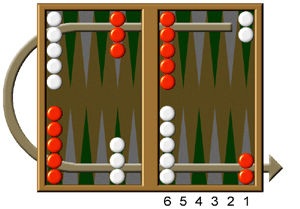 There are two ways to set up a backgammon board, both really the same. There are two ways to set up a backgammon board, both really the same.
The first illustration shows the setup when you are plaing White and your checkers move counterclockwise around the board. Red's checkers go in the opposite direction. Both players bear off to the right; you at the lower-right, your opponent at the upper-right.
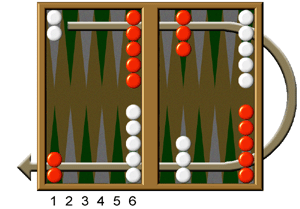 The second illustration shows the setup when your checkers move clockwise around the board. Red's checkers go in the opposite direction, and both players bear off to the left. The second illustration shows the setup when your checkers move clockwise around the board. Red's checkers go in the opposite direction, and both players bear off to the left.
Notice when you bear off to your right, your opponent will be bearing off to their left, and vice versa.
|
|
|
To decide who goes first, you and your opponent each roll one die. In the case of a tie, you both roll again. The player who rolls the higher number goes first. That player does not roll the dice again; they play the two numbers just rolled on their first turn.
Notice that the player who goes first never has doubles on their first turn because ties on the first roll are always broken.
|
|
|
The object in backgammon is to move all of your checkers around the board into your home board and then bear them off. The first player to get all their checkers off the board is the winner.
|
|
|
If you bear off all fifteen of your checkers before your opponent has borne off any of theirs, you win a gammon, or double game.
If you bear off all fifteen of your checkers before your opponent has borne off any of theirs and they have one or more checkers in your home board or on the bar, you win a backgammon, or triple game.
|
|
|
The full rules of backgammon are given here.
|
|

|
Parts of the Board
|
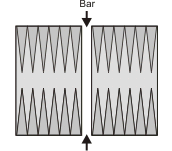 The bar is the raised ridge down the center of the board that divides the inner table from the outer table. The bar is where you place checkers after they have been hit. The bar is the raised ridge down the center of the board that divides the inner table from the outer table. The bar is where you place checkers after they have been hit.
|
|
|
Most backgammon boards fold in half. The two halves of the board are called the inner table and the outer table. The side the inner table is on depends on how you set up the checkers. If you bear your checkers off to the right, then the inner table is on your right; if you bear off to the left, then the inner table is on your left.
Your home board and your opponent's home board are both located in the inner table.
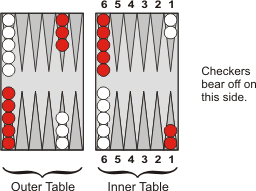
|
|
|
That is the name of the point on your opponent's side of the board where you have a stack of five checkers at the start of the game. It is also called your "13-point" because the checkers on that point are 13 spaces away from being borne off. The opponent's mid-point is your 12-point. [See diagram below.]
|
|
|
The bar-point is another name for the seven-point. It is the point next to the bar that has no checkers on it at the start of the game. [See diagram below.]
|
|
|
The ace-point is another name for the one-point, the last point you can move your checkers to before bearing them off. Your two farthest back checkers start on the opponent's ace-point.
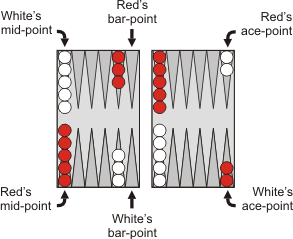
|
|

|
Moving the Checkers
|
No, you must play your roll if there is any legal way to do so. If you can't play all of your numbers, you must play as many as you can. So if you roll   and can only play three of your four 6's, that's what you must do. and can only play three of your four 6's, that's what you must do.
|
|
|
No, you must play both numbers of a roll if possible. Sometimes this means having to make a move you don't like so that your other number can also be played.
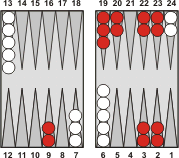 |
Whites rolls 6-4:
White can't play 13/7 with his 6 because that would leave no way to play the 4. Instead, he must play 24/18, allowing him to play 18/14 with the 4. |
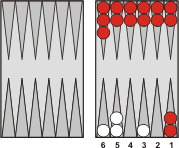 |
Whites rolls 6-4:
As much as he would like to, White cannot bear off the checker on the six-point! He must play 6/2, using his 4 first, and then use the 6 to take a checker off the five-point. |
|
|
|
If you can play one number but not both, then you must play the higher one.
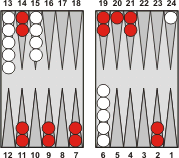 |
Whites rolls 6-4:
The only checker White can move is his runner. The rules say he must to the 18-point using the 6 rather than hit on the 20-point using the 4. |
|
|
|
Yes, if you hit a checker, you are allowed to run your hitter to safety. Here is an example:
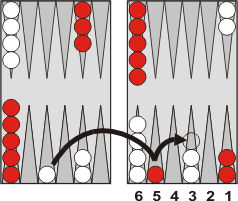 |
Whites rolls 5-2:
White may hit Red's checker on the five-point and then
move his hitter to safety on the three-point. |
There are some variations of backgammon, played in the Middle East, where hit-and-run is not allowed in the player's home board. But the standard game has no such restriction.
|
|
|
Yes, you may place as many checkers as you want on a point. Pile them one on top of another if you run out of room. There are some versions of backgammon still popular in England which allow no more than five checkers on a point (see Old English backgammon), but these are not standard rules.
|
|
|
Yes, you may play your numbers in either order, as long as each number is played legally. Using your low number first can sometimes get you out of a sticky situation. Here are some examples:
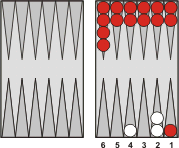 |
Whites rolls 4-1:
If White plays 4 first, he takes the checker off the four-point and is forced to hit with the 1, leaving two blots. But if he plays the 1 first, moving from the four-point to the three-point, he can then use the 4 to remove the checker from the three-point. This wastes a pip, but it leaves no shots. |
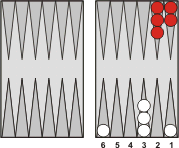 |
Whites rolls 5-4:
If White plays his 5 first, he ends up with a gap on his
two-point—not good if he rolls a 2 later. If he plays the 4 first, he fills the gap on the two-point and increases his chances of getting off in two more rolls. |
|
|
Stalement is a position in which neither player can ever move again. Technically, stalemate is not possible in backgammon. Here is a rough explanation why:
- To have a stalemate, each player would have to be blocking the other. Perhaps they each have prime in front of the other player's checkers.
- Both players cannot hold their primes forever unless they are stuck on the bar.
- If the players are both on the bar, one of them will eventually reenter unless both players are closed out.
- So the only possibility for stalemate is both players on the bar and both players closed out, like this:
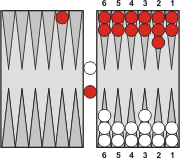
But this position can't happen. If it could, what was the position before the last hit? A player who was on the bar and closed out cannot hit his opponent.
Stalemate might be possible, though, if one of the players makes an illegal play. See this post by Bob Johnson.
|
|


|
The Doubling Cube
|
 A doubling cube is a cubical block, a little larger than a regular die, with the numbers 2, 4, 8, 16, 32, and 64 printed on its faces. It is sometimes simply called the cube. The purpose is to allow players to bet on the game as they are playing. A doubling cube is a cubical block, a little larger than a regular die, with the numbers 2, 4, 8, 16, 32, and 64 printed on its faces. It is sometimes simply called the cube. The purpose is to allow players to bet on the game as they are playing.
|
|
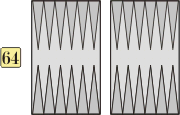 At the beginning of the game, the doubling cube is placed halfway between the players, either on the bar or at the side of the board, with the number 64 face up. The 64 means that the stakes have not been doubled yet. (Most doubling cubes do not have a 1, so the number 64 is understood to represent 1.) At the beginning of the game, the doubling cube is placed halfway between the players, either on the bar or at the side of the board, with the number 64 face up. The 64 means that the stakes have not been doubled yet. (Most doubling cubes do not have a 1, so the number 64 is understood to represent 1.)
The position of the cube, halfway between the players, indicates that both players have access to it. That is, either player can make the first double.
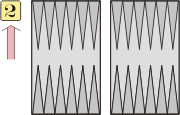 At any point during the game, a player who thinks he has a sufficient advantage may double the stakes. He can do this only at the beginning of his turn, before he has rolled the dice. At any point during the game, a player who thinks he has a sufficient advantage may double the stakes. He can do this only at the beginning of his turn, before he has rolled the dice.
When a double is offered, the opponent may refuse the double, in which case he resigns the game and forfeits the current stakes. The current stakes is the value of the cube before the double is offered, in this case one point.
If the opponent doesn't want to resign, he may accept the double, and agree to continue play at double the previous stakes. He places the cube on his side of the board with the number 2 face up. The number 2 represents the fact that the stakes are now doubled. The position of the cube means that player now owns the doubling cube and only he may make the next double.
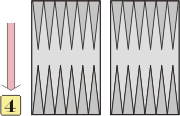 If the game later turns around and the player who owns the cube feels he now has an advantage, he may redouble the stakes to 4. His opponent may refuse and give up the current stakes (now two units) or he may accept and continue play at quadruple the initial stakes. If the game later turns around and the player who owns the cube feels he now has an advantage, he may redouble the stakes to 4. His opponent may refuse and give up the current stakes (now two units) or he may accept and continue play at quadruple the initial stakes.
There is no limit to the number of doubles and redoubles in a single game, except that no player may double twice in a row.
At the end of the game, the loser pays the winner the value of the doubling cube in whatever units they have agreed to play for. For example, if playing for one dollar a point and the doubling cube shows 4, then the loser pays the winner four dollars. In the case of a gammon or backgammon, this amount is doubled or tripled.
|
|
|
Yes, you can double at the start of any turn. You have to be alert, though; your opponent, seeing that you can't move, may roll his dice without waiting to see what you do. Just ask him to "wait, please" as he picks up his dice while you decide whether or not to double.
|
|
|
Some people play that if the two players roll the same number on the first roll of the game, then the doubling cube is automatically turned to 2. The cube stays in the middle but now the first voluntary double of the game will be offered at 4.
If the players roll the same number again, then the cube is turned up another notch, though players often agree to limit the number of automatic doubles to one per game.
|
|
|
The Jacoby rule says that a gammon or backgammon does not count extra unless the cube has been turned, that is, unless a double has been offered and accepted in the present game. The purpose of the rule is to avoid long games in which one player tries for a gammon rather than double the opponent out for one point.
Technically, the Jacoby rule is optional, but its use in money play is very common. The Jacoby rule is never used in match play.
The Jacoby rule is named for Oswald Jacoby, coauthor of The Backgammon Book, who proposed and promoted the rule. See post by Daniel Murphy.
|
|
|
If one player doubles, and the opponent accepts the double and decides his position is good enough, he may immediately redouble while retaining posession of the cube. This immediate redouble without giving up the cube is called a beaver.
For example, suppose the cube is in the center and there have been no doubles yet this game. Player A decides to double the stakes. B accepts the double (the cube now shows 2), then B says "beaver" and turns the cube up one more notch to 4. At this point, if A has second thoughts, he can decline the beaver and give up two points; otherwise the game continues with the cube at 4. B still owns the cube, so he can redouble again on a future turn. All of this happens during A's turn; A now rolls the dice and the game continues.
Playing beavers is optional, so you should agree with your opponent beforehand whether or not you are playing this rule.
|
|

|
Procedure and Etiquette
|
Your goal when rolling the dice is to do your best to show that your rolls are random and fair. Here is the recommended procedure:
- Use a dice cup! (A good dice cup has a ridge around the inside lip to trip up the dice as they come out.)
- Use dice with rounded corners so they roll easily.
- Place the dice in the cup, cover the opening of the cup with one hand, and shake the cup vigorously a few times so that you can hear the dice clicking against each other inside.
- Remove your hand from the cup and drop the dice from a reasonable height onto the board so that both dice roll several times before stopping.
- If one die comes out of the cup before the other, stop, pick up the refugee die, put it back in the cup, and start over.
It takes a little practice to make all this happen just right, but good dice-rolling technique makes the game more pleasant for both players. See this post.
|
|
|
Dice are said to be cocked if they do not land flat on the playing surface of the thrower's righthand side of the board. If a die lands on a checker, on the bar, or on the wrong side of the board, both dice must be rethrown. (Except on the opening roll, when only the player whose die was cocked rerolls.)
|
|
|
No, if you touch a checker you are not required to move it. In fact, you can move one or more checkers, think for a while, and then move those checkers back and make a completely different move.
Try not to overdo this, though. Backgammon is supposed to be a fast-paced game and a lot of checker shuffling just slows things down. It is a good idea to observe the following rules of etiquette when trying out moves:
- Move your checkers using only one hand to make it easier for your opponent to follow what you're doing. See this post.
- Place tentative moves slightly away from the checkers already on each point, or slightly away from the edge of the board if the point is empty. That way you can remember which checkers you moved.
- Return the checkers in the reverse order that you played them. It's best to undo a move completely before trying a different move.
|
|
|
Your turn is over when you pick up the dice.
|
|
- If you make an illegal move and notice the error before you pick up the dice, you can (and should) correct it.
- If you notice the error after you have picked up the dice, then it's up to your opponent whether or not to allow you to correct the error. If he asks you to fix it, you must take your illegal move back, but then you are free to make any legal move consistent with the original roll.
- If the error goes unnoticed until after the opponent has rolled his dice, then it's too late; your play is final and no changes are allowed.
|
|

|
Backgammon Notation
|
|
Modern backgammon books use the numbering system shown below for representing the movement of checkers.
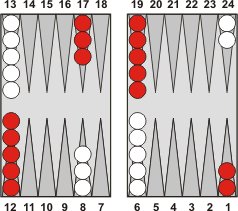
The points are numbered from the point of view of the player whose turn it is to play. So actually there are two sets of numbering, one for each player. Your one-point is your opponent's 24-point, your five-point is your opponent's 20-point, etc. While this might seem confusing at first, it quickly becomes natural.
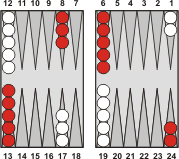 |
Points are numbered backwards when it is your opponent's turn to play. (Note that checkers always move from higher-numbered points to lower-numbered points.) |
Checkers on the bar are represented by the word "bar". Checkers that are borne off are represented by the word "off".
It wasn't always this way. In the olden days (prior to about 1980), books used a 12-point numbering system, where the points on each side of the board were numbered from 1 to 12. You used a prefix, such as W12 or B12 to distinguish the two 12-points. Experience has shown that a 24-point system works better and is less confusing.
|
|
|
To show the movement of a single checker, you write the point number that the checker starts at, then a slash, then the point number where the checker ends up. For example, if a checker moves from the eight-point to the five-point, you write "8/5". If a checker moves from the mid-point (the 13-point) to the bar-point (the 7-point), you write 13/7.
If the same checker moves twice, using both numbers of the dice, it is not necessary to show the intermediate point that the checker touches down on; just write the starting point and the final stopping point. For example, the traditional play of lovers-leap with an opening 6-5 is written as 24/13; you don't need to show the two separate moves, 24/18 and 18/13.
There is one exception to this rule of omitting the intermediate point number. If a blot gets hit along the way, then you must show the intermediate point. For example, you would write 24/18*/13 if there is a blot on the 18-point.
|
|
|
The following match was played between Nack Ballard and Jerry Grandell in 1998, two of the very best players in the world. Test your skills at reading backgammon notation by setting up a board and following along in this interesting game.
The transcript is presented in two columns, one column for White's plays and one column for Black's plays. The roll is shown first, then the checker play. Here Nack Ballard went first; the opening roll was 4 and 2 and he played it in the usual way, moving one checker from the eight-point and another from the six-point to make the four-point.
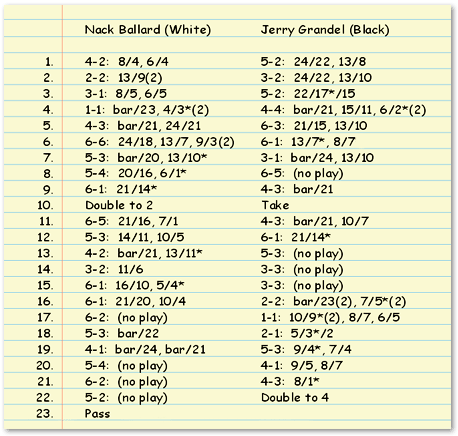
|
|
|
An asterisk after a number means that a checker on that point was hit. For example, "24/23*" means a checker on the 24-point hit a blot on the 23-point.
|
|
|
With rolls of doubles, there are often two, three, or even four checkers that move together. It is customary to write these parallel moves just once and use parentheses to indicate the number of checkers that move. For example, you would write "24/18(2), 13/7(2)" to indicate that two checkers on the 24-point move to the 18-point and two checkers on the 13-point move to the seven-point.
|
|

Return to
: Backgammon Galore
: FAQ

|











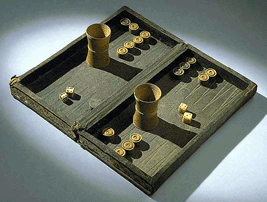
 There are two ways to set up a backgammon board, both really the same.
There are two ways to set up a backgammon board, both really the same.
 The second illustration shows the setup when your checkers move clockwise around the board. Red's checkers go in the opposite direction, and both players bear off to the left.
The second illustration shows the setup when your checkers move clockwise around the board. Red's checkers go in the opposite direction, and both players bear off to the left.
 The bar is the raised ridge down the center of the board that divides the
The bar is the raised ridge down the center of the board that divides the 









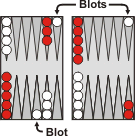 A blot is a checker residing alone on a point. If an opposing checker lands on your blot, the blot is
A blot is a checker residing alone on a point. If an opposing checker lands on your blot, the blot is  A prime is six consecutive made points. If you make a prime in front of the opponent's checkers, he will not be able to get past you until you break one or more points of the prime.
A prime is six consecutive made points. If you make a prime in front of the opponent's checkers, he will not be able to get past you until you break one or more points of the prime.
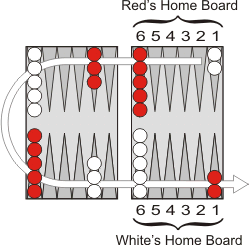
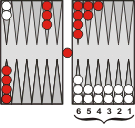 A player who makes all six points of his home board is said to have a closed board. If you get one of your checkers
A player who makes all six points of his home board is said to have a closed board. If you get one of your checkers  A doubling cube is a cubical block, a little larger than a regular die, with the numbers 2, 4, 8, 16, 32, and 64 printed on its faces. It is sometimes simply called the
A doubling cube is a cubical block, a little larger than a regular die, with the numbers 2, 4, 8, 16, 32, and 64 printed on its faces. It is sometimes simply called the  At the beginning of the game, the doubling cube is placed halfway between the players, either on the bar or at the side of the board, with the number 64 face up. The 64 means that the stakes have not been doubled yet. (Most doubling cubes do not have a 1, so the number 64 is understood to represent 1.)
At the beginning of the game, the doubling cube is placed halfway between the players, either on the bar or at the side of the board, with the number 64 face up. The 64 means that the stakes have not been doubled yet. (Most doubling cubes do not have a 1, so the number 64 is understood to represent 1.)
 At any point during the game, a player who thinks he has a sufficient advantage may
At any point during the game, a player who thinks he has a sufficient advantage may  If the game later turns around and the player who owns the cube feels he now has an advantage, he may redouble the stakes to 4. His opponent may refuse and give up the current stakes (now two units) or he may accept and continue play at quadruple the initial stakes.
If the game later turns around and the player who owns the cube feels he now has an advantage, he may redouble the stakes to 4. His opponent may refuse and give up the current stakes (now two units) or he may accept and continue play at quadruple the initial stakes.



